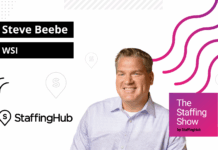
By John Younger, JobElephant Talent Acquisition Team
Key takeaways:
- AI enhances efficiency, but EQ drives connection: While AI supports every stage of recruiting (profiling, job descriptions, distribution, screening, interviewing, and offers), emotional intelligence ensures cultural alignment, trust-building, and candidate engagement.
- The best results come from blending AI and human insight: Recruiters should use AI for data analysis, pattern recognition, and scalability, while applying human empathy and judgment to assess motivation, culture fit, and long-term potential.
- Relationship-building remains decisive: From crafting compelling job descriptions to negotiating offers, maintaining empathy, curiosity, and candidate-centric communication turns applicants into advocates and secures lasting hires.
In today’s recruitment landscape, artificial intelligence tools update and evolve at a breakneck pace. While these technological advancements offer tremendous potential, the most successful recruiters recognize that emotional intelligence remains the critical differentiator in winning the talent war.
The staffing industry faces a pivotal moment as AI capabilities expand exponentially. According to recent data from StaffingHub, over 60% of staffing firms have adopted some form of AI in their recruitment processes. Yet many organizations struggle to connect the dots between comprehensive AI integration and recruitment success.
The key lies in strategically weaving AI into all six primary steps of recruiting while maintaining the human connection that candidates crave through Emotional Quotient (EQ), which is a measure of a person’s emotional intelligence.
The six primary steps of recruiting and AI’s role
1. Profile the job
Before posting any position, recruiters must understand why the position is open, why the right person would want this job, and recognize common attributes of top employees. AI excels at providing market data and identifying patterns in successful hires, but falls short in understanding organizational culture and job significance.
When extracting job requirements using AI, recruiters can take an initial glance by analyzing the hiring manager’s LinkedIn profile or resume along with company information. AI will do a solid job of starting to understand the role, but personalities, dynamics, culture, and leadership style require human insight. AI cannot fully grasp the nuances of team dynamics or the unwritten cultural elements that make someone successful within a specific organization.
Effective job profiling combines AI analysis with human understanding. A recruiter might use AI to generate a baseline profile, then meet with the hiring manager to discuss the pain points driving the need for this position. This conversation reveals the true motivations behind the hire and helps articulate why the right candidate would find this role compelling. The AI tells you what the market wants, EQ, helps articulate why the role matters. This combination creates a complete picture that neither technology nor humans can achieve alone.
2. Craft the job description
One common mistake in recruitment is failing to explain why a job matters. Most job descriptions simply list what a marketing manager does, information candidates already know. The critical question is why they should care.
AI can identify language that resonates with ideal candidates and create targeted messaging for specific candidate profiles.
A truly effective job description functions as a personal letter to the ideal candidate rather than an announcement to the world. Consider the difference between a standard job posting that lists responsibilities and requirements versus one that speaks directly to the candidate about the impact they will make and how this role advances their career goals. When written in the language of the community, these descriptions naturally circulate among the right people.
Organizations that master this balance between AI optimization and human connection see significantly higher quality applications and engagement rates. The job description becomes a filtering mechanism that attracts precisely the right candidates.
3. Find people and distribution
While distribution is technically easy, standing out in a crowded recruitment field remains challenging. AI streamlines posting jobs across multiple platforms and targets specific candidate pools with precision. Distribution presents a paradox. Technology makes it simple to blast job postings across the internet with a few clicks. The difficulty comes in breaking through the bombardment of messages that candidates receive daily.
AI tools can analyze data to determine which platforms yield the best candidates for specific roles. They can optimize posting times, tailor messaging for different channels, and even predict which passive candidates might be open to new opportunities. AI algorithms also maximize recruitment advertising ROI by allocating budget to the highest performing channels and eliminating spend on platforms that deliver poor results.
However, technology alone cannot build trust. The EQ component comes in when tapping into networks, referrals, and personalized outreach. A message from a trusted source gets attention and action, even if the recipient isn’t the right fit. They’re more likely to refer someone who is, creating a ripple effect that technology alone cannot achieve.
Successful recruiters combine AI distribution with human networking. They might use AI to identify alumni from specific schools or former employees of target companies, then leverage personal connections to reach out with customized messages. This combination of technological precision and human connection yields significantly better results than either approach alone.
4. Screen people
Moving beyond the limitations of resumes, AI helps connect the dots between role requirements and candidate qualifications. Implementing objective scoring systems brings consistency to the screening process.
Resumes often fail to provide an accurate picture of candidates and contain inaccuracies, both major and minor. The key is getting underneath the resume to connect the dots between the role and the person. AI excels at this pattern matching and scoring, bringing objectivity to what can otherwise be a subjective process.
Advanced screening systems use AI to generate role-specific questions that reveal capabilities beyond what appears on paper. These might include scenario based questions, technical assessments, or behavioral inquiries that predict success in the role. The AI then scores responses objectively, removing human bias from initial evaluations.
Human EQ becomes essential when screening for qualities like curiosity, drive, and ethics. Curiosity serves as a proxy for both humility and intelligence, traits that AI struggles to assess accurately. A curious candidate asks thoughtful questions, demonstrates willingness to learn, and shows intellectual humility.
The most effective screening combines AI efficiency with human judgment. AI might identify the top 20 candidates based on objective criteria, allowing recruiters to focus their time on evaluating the human elements that predict success. This partnership between technology and human insight leads to better quality hires and reduced turnover.
5. Interview and select with precision
Interview quality varies widely among hiring managers. AI can standardize processes by generating interview questions based on job descriptions and requirements, ensuring consistency while allowing human interviewers to focus on assessing cultural fit and potential.
AI tools now generate interview guides tailored to specific roles, ensuring all candidates face consistent evaluation. These systems can suggest questions that probe for specific competencies, track interviewer assessments, and even analyze language patterns during interviews to identify potential biases or areas for deeper exploration.
The contrary evidence technique proves valuable here. If someone impresses in one way, treat it as a thesis rather than a conclusion, then ask questions to test that thesis. For example, if a candidate appears to be an exceptional communicator, the interviewer might ask about situations where their communication failed and what they learned. This approach leads to more balanced evaluations and better hiring decisions.
The EQ component extends beyond assessment to brand building. Every candidate interaction creates an impression of the organization. Savvy recruiters ensure that even rejected candidates walk away as brand advocates. This approach recognizes that today’s rejected candidate might become tomorrow’s customer, referral source, or future hire.
6. Negotiate, close, and onboard
Many companies falter at this critical stage. AI provides valuable trends and market data for compensation decisions, while human recruiters bring nuance to final negotiations.
The traditional approach of sending a formal offer letter immediately turns the process binary and transactional. A more effective method uses AI-generated market data to inform a conversation about compensation and benefits. This approach allows for adjustment and alignment before formalizing the offer, leading to close rates approaching 100% because there are no surprises.
Successful recruiters use a pre-closing technique. They discuss potential compensation packages conversationally, asking candidates for feedback before formalizing anything in writing. This approach allows both parties to align expectations and address concerns before reaching the binary yes or no stage. When the formal offer finally arrives, it contains no surprises and confirms what both parties have already agreed to.
The key principle is relationship building. When candidates feel heard and valued during negotiations, they enter the organization with positive expectations and greater commitment. This approach reduces the risk of candidates accepting counteroffers or continuing to interview elsewhere after accepting a position.
Weaving intelligence with empathy
The risk of over-automation in recruitment is real. While AI excels at processing vast amounts of data and identifying patterns, empathy remains the cornerstone of effective recruiting. Organizations that successfully balance technology and humanity create superior candidate experiences.
The future of AI in recruitment isn’t about replacement but enhancement. As AI tools continue their weekly evolution, the organizations that successfully balance intelligence with empathy will win the talent war. The most successful recruiters will embrace AI’s capabilities while preserving the human connection that ultimately drives candidate decisions.
 John Younger, of JobElephant’s Talent Acquisition Team, is a Notre Dame Math/CS graduate and MIT AI program alum. Founder of six companies with multiple patents, he pioneers AI-driven hiring solutions, blending technical expertise and recruiting innovation to create modern, efficient, and human-centered talent acquisition strategies.
John Younger, of JobElephant’s Talent Acquisition Team, is a Notre Dame Math/CS graduate and MIT AI program alum. Founder of six companies with multiple patents, he pioneers AI-driven hiring solutions, blending technical expertise and recruiting innovation to create modern, efficient, and human-centered talent acquisition strategies.





